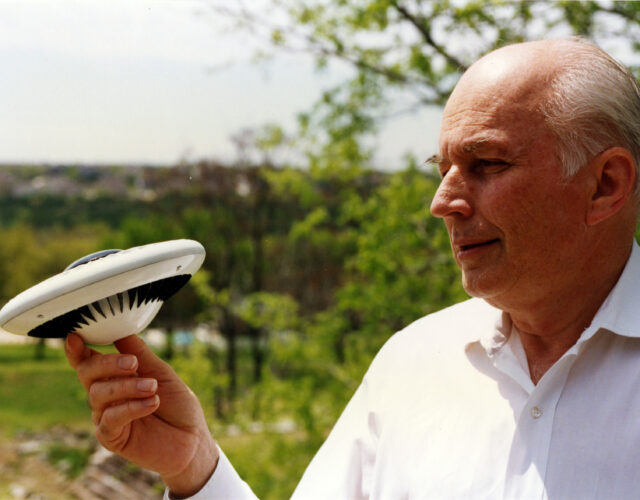In the summer of 2016 Steve Shoulders was getting by on odd jobs, doing everything from tree trimming to electrical repair around Freestone, California, a rural community of 50 people in Sonoma County. It was honest work but less rewarding than the years spent under the tutelage of his father, Ken Shoulders. Working mostly from backyard laboratories, the pair spent decades designing flying machines and challenging scientific assumptions.
After his father died of cancer in 2013, Steve was left with the remains of a life spent inventing: drone prototypes, dust-covered lab equipment, brittle research papers, even an old gyrocopter, a type of helicopter with small wings and an airplane propeller. But now those objects were in danger of being lost forever. Unable to pay the rising rent, he was being forced out of his home and was scrambling to find storage space for his father’s legacy.
When we spoke with Steve, he was standing on a hilltop a couple of miles from his father’s lab, straining to maintain cell reception as wind battered his phone’s speaker. “Working with my father was an absolute joy,” he said. “He was just a really good friend of mine, if nothing else.”
Ken Shoulders would wake each morning between 3:00 and 3:30 to sit outside until sunrise. It was his private time to contemplate new ideas and experiments; no one was allowed to interrupt him. Each day he ate his breakfast from the same bowl and spoon; he would wash them and thereby extricate himself from the rest of the household chores. By simplifying tasks Shoulders hoped to save all his mental energy for his work.
“Anything added to simplicity was complexity,” explained his son. “Complexity was going to confuse him or do something to his thought processes that he didn’t need.”
Shoulders’s peculiar sense of pragmatism could alienate people who didn’t know him, and it was part of a larger rejection of convention that started at a young age. Born in Texas in 1927, he barely finished high school, shrugging off homework he found tedious to pursue his interests in electronics and what he later called “frontier science.” One of the few school subjects that captured his attention was aeronautics; his high marks in that class were an early indication of an enduring fondness for machines that could fly. Despite his mediocre grades young Shoulders was clearly bright. He had a remarkable ability to take a device apart and put it back together again to figure out exactly how it worked.
In following the ideas of “frontier science” Shoulders made a life of taking the harder path.
Forgoing college, he spent the next decade bouncing among different electronics jobs at companies big (Magnavox, Texas Instruments) and small (radio station WKWF in the Florida Keys). By 1955 he settled into a research staff position at MIT’s Computer Components and Systems Laboratory. Three years later Shoulders’s self-taught knowledge in the booming field of microelectronics landed him a prestigious job at the Stanford Research Institute (SRI) in California.
Shoulders founded SRI’s microelectronics program and directed the work of a team of engineers and technicians who made research machinery, such as mass spectrometers, ultra-high vacuum apparatuses, and electron-beam instruments. He would ride to work each day on a Vespa scooter, careening down twisting, redwood-lined roads into the congestion of Palo Alto. But he would have preferred to ditch the traffic of Bay Area streets for empty skies, and so he set his engineering mind to sorting out a solution.
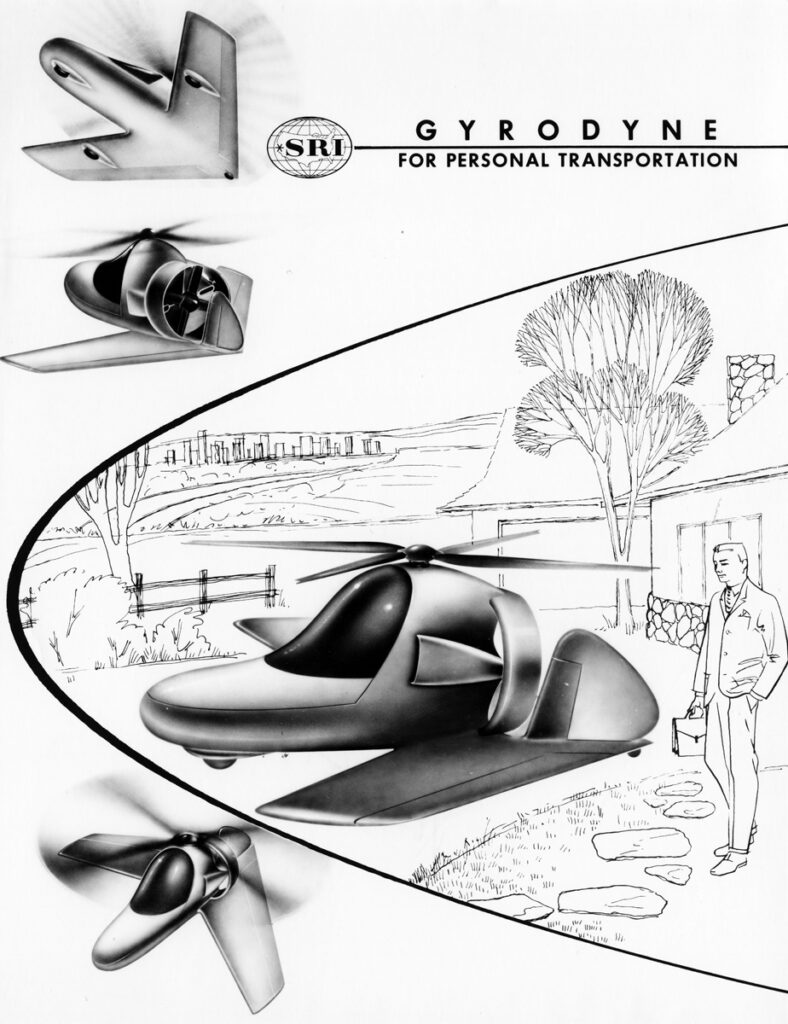
Promotional handout for the Gyrodyne Convertiplane, an aircraft Shoulders believed could change how people commuted to work.
After working at SRI for a few years he convinced his bosses to allow him to design a car capable of flight. He called it the Gyrodyne Convertiplane, essentially a cross between a car, a helicopter, and an airplane. Although designed to be flown primarily like a small airplane, a rotor on the vehicle’s roof would allow it to take off and land from short stretches of road. Rigid wings and a rear propeller would let it travel farther and faster than most helicopters available at the time.
A 1965 proposal lays out Shoulders’s vision for the Convertiplane, complete with preliminary sketches and specifications, and addresses operational and logistical concerns. He saw the vehicle as the answer for a “large and growing” population of long-distance commuters who lived 80 or more miles from work and who were tired of battling hours of traffic each day.
Shoulders had hit on an unusual solution to a real problem. Since the end of World War II more Americans were buying cars than ever before and moving into suburbs farther and farther from urban centers. Existing highway infrastructure couldn’t handle the change. By 1960 there were more than 61 million registered passenger vehicles on American roads, double the amount of 10 years earlier. President Dwight Eisenhower foresaw the problem and convinced Congress to pass the Federal-Aid Highway Act in 1956.
By the time Shoulders was pitching his Convertiplane, a national system of interstate highways was slowly being built. But Shoulders saw a simpler fix; with his Convertiplane a person could bypass congested roads with the flip of a switch and launch into the sky. No more traffic, at least for the people lucky enough to own such a craft. (He never offered a solution, however, for managing the crowded airspace once everyone was flying.)
Why would SRI support such a far-fetched idea? In the decades following World War II it probably didn’t seem all that outlandish. The era was flush with government grants and an eagerness to experiment, especially if the results might keep the United States ahead of the Soviet Union. SRI was at the heart of this scientific free-for-all. A decade after Shoulders pitched his flying car, Harold Puthoff, a friend and physicist at SRI, began a bizarre project funded by the CIA. Puthoff had become fascinated with illusionists, including talk-show staple Uri Geller, who professed psychic powers. Puthoff began investigating whether those powers were real and whether they might have military applications. Puthoff and his collaborators conducted a number of experiments and concluded that Geller could, in fact, read minds and move objects through telekinesis. Other researchers couldn’t replicate the results.
Although many of these off-the-wall projects failed to produce anything tangible, the freedom given to employees at SRI paid off over time. Since the 1960s, SRI researchers have had a hand in innovations ranging from cancer drugs to Apple’s Siri voice-recognition software. Unfortunately for Shoulders the Convertiplane was a project that never took off. Aside from technical and logistical problems, a gamut of legal obstacles blocked the way.
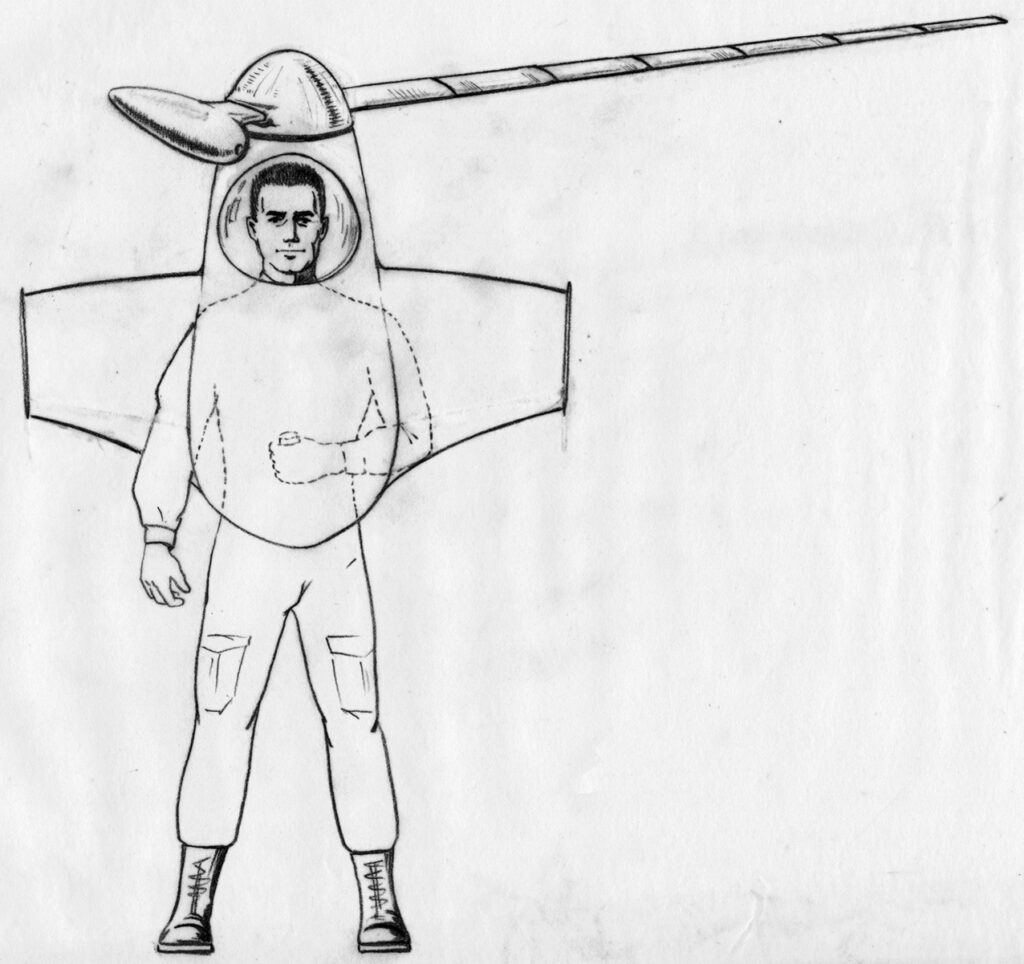
Sketch of the military-focused Helicopter Escape and Rescue Outfit (HERO), one of two solo aircraft Shoulders designed while at SRI, ca. mid-1960s.
Shoulders met with the California State Senate’s Transportation Committee in 1963 to ask permission to use his invention. He argued that flying cars were technologically and economically viable and would not require extensive changes to California’s existing transportation infrastructure. If he had to work within the bounds of government regulation, he suggested using a loophole: flying cars could be classified as motorcycles, which had fewer design restrictions when compared with cars. The Transportation Committee members said they would think about it.
No matter how outlandish, Shoulders never rejected a new theory before carefully thinking it over and, if appropriate, testing it. He wished others would extend him the same courtesy.
In early 1964 the California Highway Transportation Agency made a decision: his flying car would be allowed to drive on public roads. Shoulders was overjoyed, but he had only cleared the first of many bureaucratic obstacles. According to Steve Shoulders a number of nearby municipalities, including Palo Alto, forbade the Convertiplane from flying through their airspace, possibly because they were afraid that insurance companies wouldn’t cover flying cars. Ken Shoulders was baffled. He later wrote, “There is nothing intrinsically different between flying a helicopter and driving a car, but a gulf has been created between the two methods by some quirk of social and economic manipulation.”
In response Shoulders pulled back on research into manned aircraft and for the next few years concentrated on building mass spectrometers and drone aircraft. These setbacks coincided with a growing disillusionment at work. Shoulders believed that great inventions could only be conceived through the vision of an individual scientist, and that the boards and committees at SRI stifled his creativity. Late in 1968, and just shy of a decade spent at SRI, Shoulders decided he could no longer follow someone else’s research agenda and left SRI to pursue his own interests: designing and building experimental aircraft. It was a rash decision even for him. According to his son had Shoulders stayed just two more months, he would have left with a generous retirement package, giving him plenty of cushion to strike out on his own. But Shoulders could think only of flying away.
Shoulders was still convinced that a vehicle like the Gyrodyne Convertiplane could revolutionize transportation. While he tried to identify a new source of funding for the idea, he set up a backyard laboratory and workshop for developing remote-controlled drones. While most drones being built at the time were designed for military applications, Shoulders envisioned machines that would be used for everything from toys to crop dusters. He incorporated his work into a company he named Vertitek. In place of graduate students and technicians, Shoulders enlisted the help of novices who like himself had little formal education, often hitchhikers he would come across. Even his young son, Steve, would lend a hand in the lab.
As with his hiring practices Shoulders’s drone designs could be eccentric. The Boomerang looked like a giant maple seed, the kind that pinwheels down when thrown in the air. But the craft’s odd appearance belied the cutting-edge technology onboard. It was able to avoid collisions by bouncing sound waves off obstacles, similar to the way a bat uses echolocation to navigate. The inventions were marvels of engineering, says Steve, but they could be dangerous too. If something was to go wrong, the Boomerang’s large propeller could easily lop off the head of a bystander.
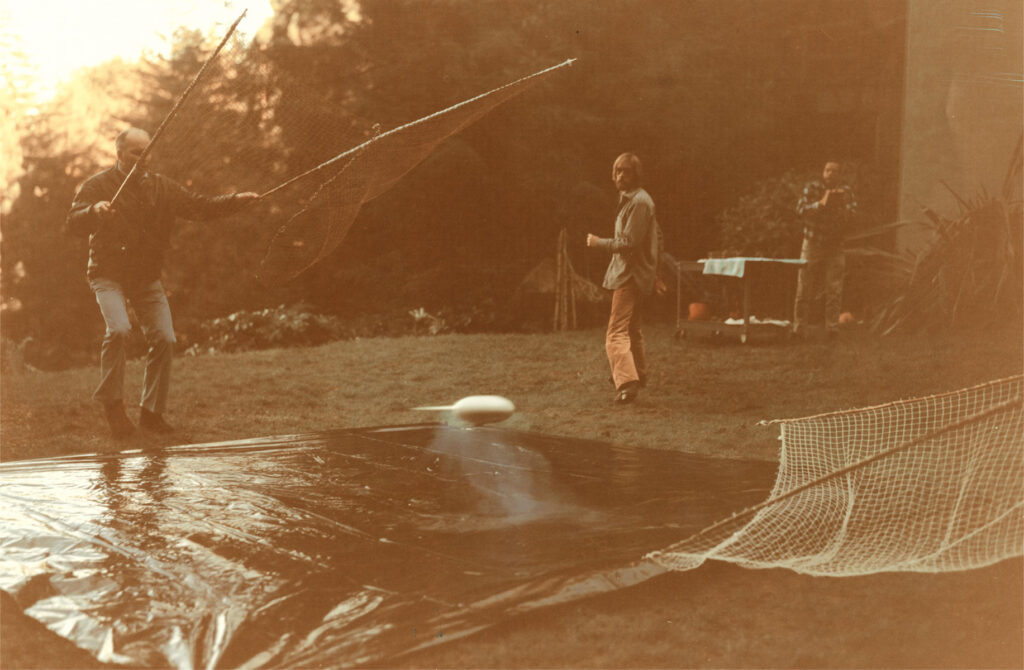
Shoulders and assistants wrangling the Boomerang, a self-navigating drone of his design, ca. 1970.
Shoulders built drones out of his backyard lab for many years, but eventually he realized that if he ever wanted to build a flying machine he could pilot himself, he needed a lot of money. He was also looking for a fresh area of research, something he’d later describe as “really nuts.” Who better to ask for help in this pursuit than his old friend Puthoff?
Shoulders went to see Puthoff at SRI one in day in 1976. As luck would have it, Puthoff had just spoken with his wealthy friend George “Bill” Church, the owner and CEO of the Church’s Fried Chicken fast-food chain. Church had told Puthoff about a recent dream in which a flying saucer landed before him, out of which walked a man with remarkably large shoulders. As soon as Puthoff hung up the phone, Shoulders walked into his office looking for money. To a man pursuing the paranormal it seemed prophetic. Puthoff called Church back immediately, exclaiming that he was face to face with a large-shouldered man named Ken Shoulders.
Church and Shoulders set up a meeting soon after. Although Shoulders distrusted businessmen in general, he was charmed by Church. Like many others living through the oil crisis of the 1970s, Church was interested in alternative sources of energy, and he was eager to fund research in that direction. Shoulders was game, and over the next few weeks the pair negotiated an arrangement in which Church would finance Shoulders’s experiments and pay him a salary to run a lab; in return Church would share the profits from anything Shoulders invented.
After working in California for nearly a decade—first from his home in Woodside, then later in a lab Shoulders designed and built himself closer to the coast—Church asked Shoulders in 1984 to take charge of a state-of-the-art lab he was building in Austin, Texas, Church’s home base. The promise of complete creative and financial freedom was too tempting to resist. They organized themselves as a new company, Jupiter Technologies, and hired a staff of scientists and technicians. Soon Shoulders had designed a number of microelectronics for market, including a millimeter-wave generator and a new type of digital display he pitched to the Defense Advanced Research Projects Agency (DARPA) without success.
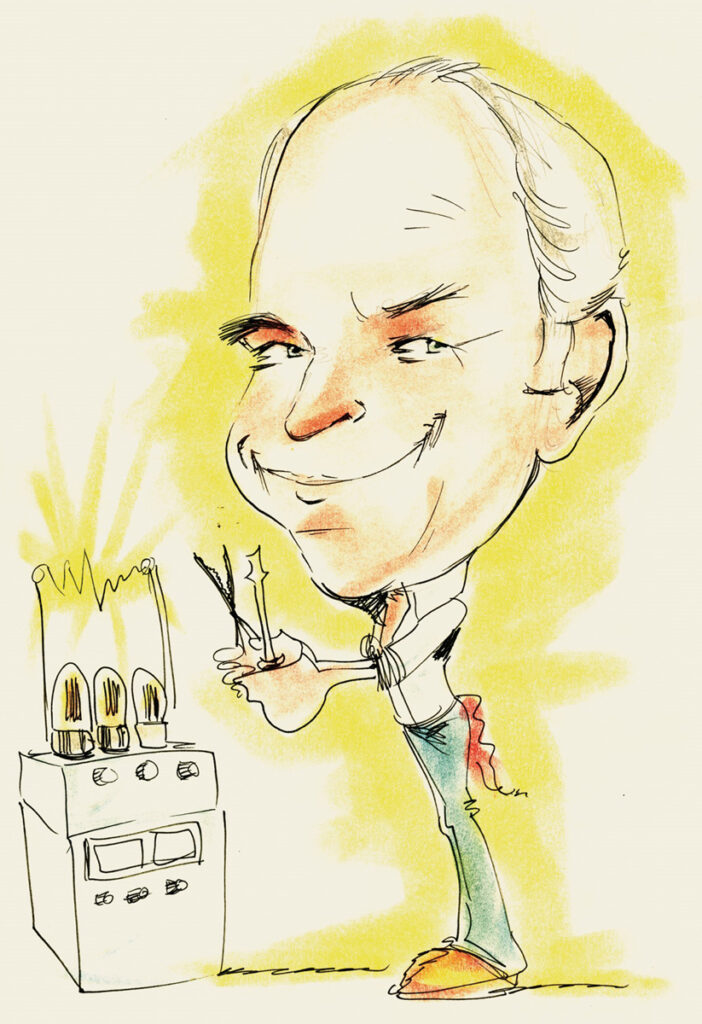
Caricature of Ken Shoulders drawn during his time in Austin, Texas, 1988.
As time went on, the two men found they had a lot in common and became close friends. Both were Texans who loved science but harbored a disdain for the constraints of higher education. Church would often stay late at the lab to quiz Shoulders about his progress and research methods, phoning in to the local outlet of his restaurant chain to have a dinner of fried chicken delivered to keep the discussions rolling.
Funding and chicken in hand, Shoulders believed he finally had the stability he needed to build a personal aircraft. Using his experience with the Gyrodyne Convertiplane and the dozens of remote-controlled drones he had built over the previous decade, he created a prototype gyrocopter with a lightweight metal skeleton he intended to modify incrementally into a flying car. He designed and built a pair of rockets fueled by hydrogen peroxide that in theory would allow the gyrocopter to launch vertically from a city street. After launch the vehicle’s propeller would provide stable flight. Shoulders often flew the prototype around his property for fun, though the rockets never got past the testing stage.
Shoulders suffered from extreme motion sickness, which led him to fly very low to avoid turbulence and the upset stomach that came with it. His motion sickness grew so debilitating he couldn’t even look at a Ferris wheel without getting ill. Still, the freedom he felt while in the air, untethered from the snarl of traffic, made his trips worthwhile.
But Shoulders’s belly wasn’t the only obstacle to commuting by flying car. It turned out that actually building one of the things was harder than he thought. At the same time, the cheery façade presented by his friend and business partner Church was starting to flake away. In 1989 Church began delaying a promised $10,000 bonus and laid off part of Jupiter’s staff. Church’s enthusiasm for Shoulders’s work endured, but he could no longer afford to finance Jupiter by himself, especially when none of the lab’s projects were producing a profit.
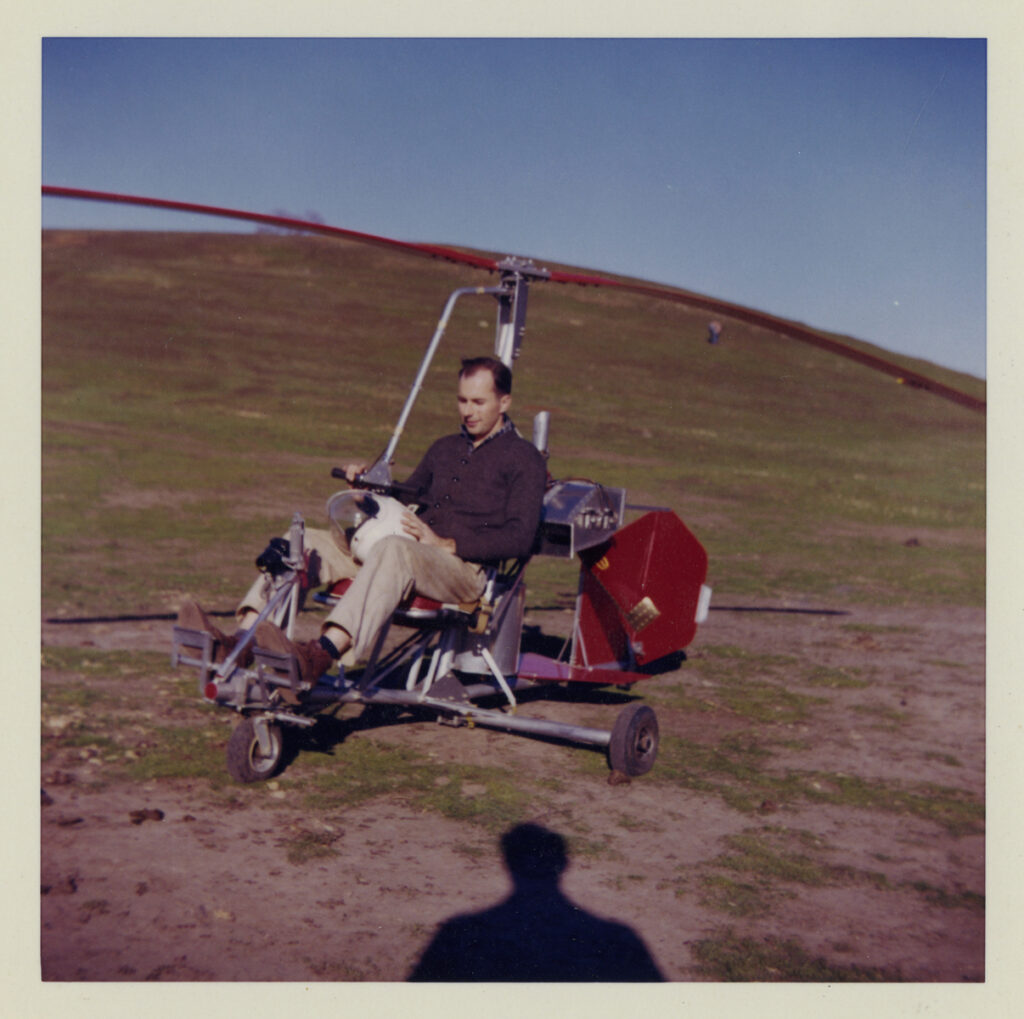
Despite developing acute motion sickness, Ken Shoulders flew solo aircraft for much of his life. Here a young Shoulders sits in the cockpit of a Bensen B-8M Gyro-Copter in 1962.
For a time Church tried to hide the depth of his financial straits. When Shoulders discovered the truth, he was outraged, and the partnership soon dissolved. By 1990 he wasn’t any closer to turning his gyrocopter into a full-fledged flying car, and he no longer had Church’s financial support. Jupiter Technologies shut its doors. For four years Shoulders finished off contractual obligations and continued his alternative-energy research out of Jupiter’s former lab before returning to California in 1994. In 1995 he found a new financier from Sonoma County, California, who would fund him for the next 10 years. According to Steve, “From a 30-minute meeting and a handshake agreement we moved to Freestone.”
At some point Shoulders abandoned manned aircraft altogether. When he received a request from two young family friends seeking advice for breaking into the personal-aircraft industry, Shoulders shooed them away from the idea. He warned them of the political and legal hurdles they would encounter, while bitterly recounting his own experience. The young men heeded the weary inventor’s warnings: one kept his job at Boeing, while the other, in Shoulders’s words, “took off for Tahiti in a sailboat with a beautiful lady.”
In the Freestone lab Shoulders returned to the experimental physics projects he had pursued early in his partnership with Church.
While working with his son sometime around 1980, Shoulders had replicated a phenomenon observed by William Bostick, an atomic physicist at the Stevens Institute of Technology. Shoulders would eventually dub his findings exotic vacuum objects, or EVOs. He described an EVO as a cluster of electrons that channels energy (though the source of that energy was uncertain). Shoulders believed he had used the electrons’ energy to melt microscopic holes in various materials. Church had offered their research to dozens of companies and government agencies, including the Office of the Vice President, but no one was interested.
EVOs break the laws of physics as they are currently understood. Electrons shouldn’t be able to cluster together, as Shoulders claimed, because an electron’s negative charge will repel other electrons. Anyone trying to hold together the north poles of two magnets will get a sense of the problem. And so when Shoulders presented his findings to established scientists, such as Richard Feynman, a Nobel laureate physicist at Caltech, he was dismissed outright.
Shoulders’s credibility was not helped by his maverick reputation, his lack of formal education, or the company he kept. Puthoff, his closest friend at SRI, was a former Scientologist who was still convinced that Uri Geller had psychic powers. Shoulders had also become close to John Hutchison, who promotes himself as a lovemaking guru and the inventor of levitation and life-extending devices. These relationships, and many others with more conventional scientists, were the result of Shoulders’s openness to unusual ideas. No matter how outlandish, Shoulders never rejected a new theory before carefully thinking it over and, if appropriate, testing it. He wished others would extend him the same courtesy.
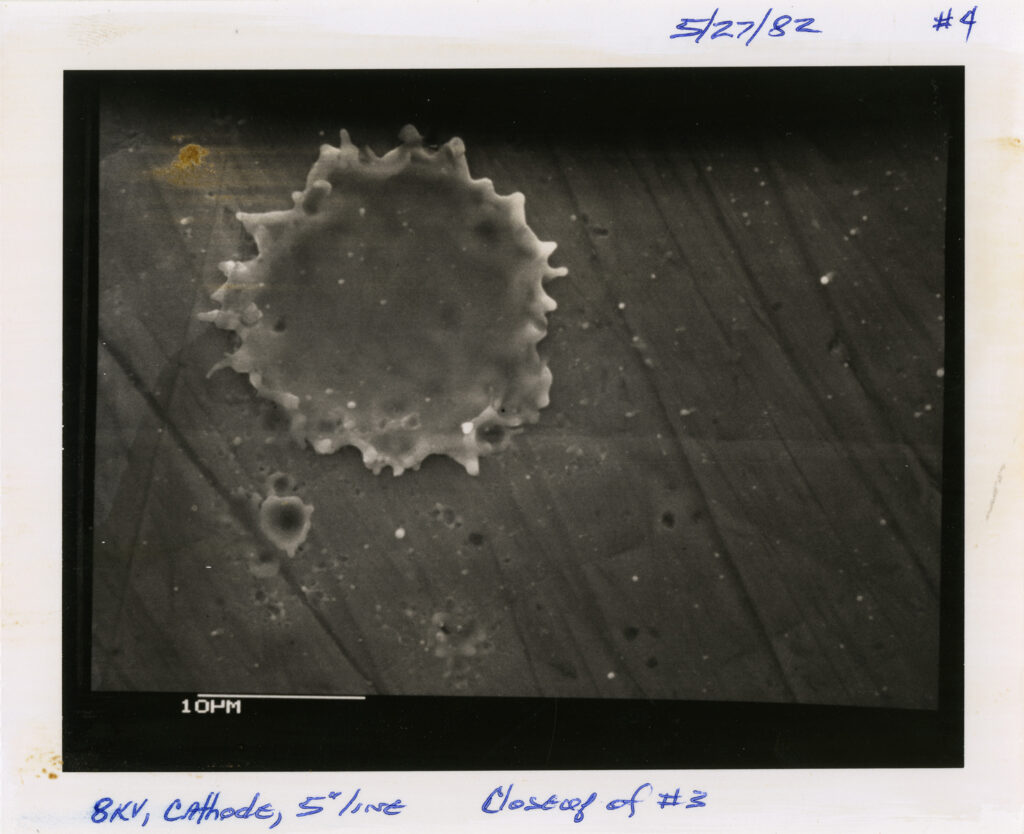
Photograph from Shoulders’s testing of EVOs, which he hoped would be key to an alternative-energy source.
But was there any worthwhile science in Shoulders’s EVO research? After dismissing the inventor’s findings, Feynman became aware of the discovery of similar clusters of charged particles made at the National Bureau of Standards and the work of a professor at the University of California, San Diego, who had noticed the same thing 10 years earlier but had not conducted further research. On January 31, 1986, Feynman mailed an apology letter to Shoulders: “When you were in my office I could not see how 1010 or 1011 electrons could be kept as a ball in a vacuum without ions. . . . I must apologize for it has come to my attention that it is indeed possible.” Feynman confirmed that the electron clusters Shoulders and his son witnessed were feasible, a small victory in the face of mass rejection. But the existence of a physical phenomenon is a far cry from an alternative energy source. Nonetheless, Shoulders declared in his self-published book, EV: A Tale of Discovery, “I believe this gateway will open into one of the greatest industries yet known.” Despite years of filing patents and pitching the research to various companies and government agencies, Shoulders never found a taker.
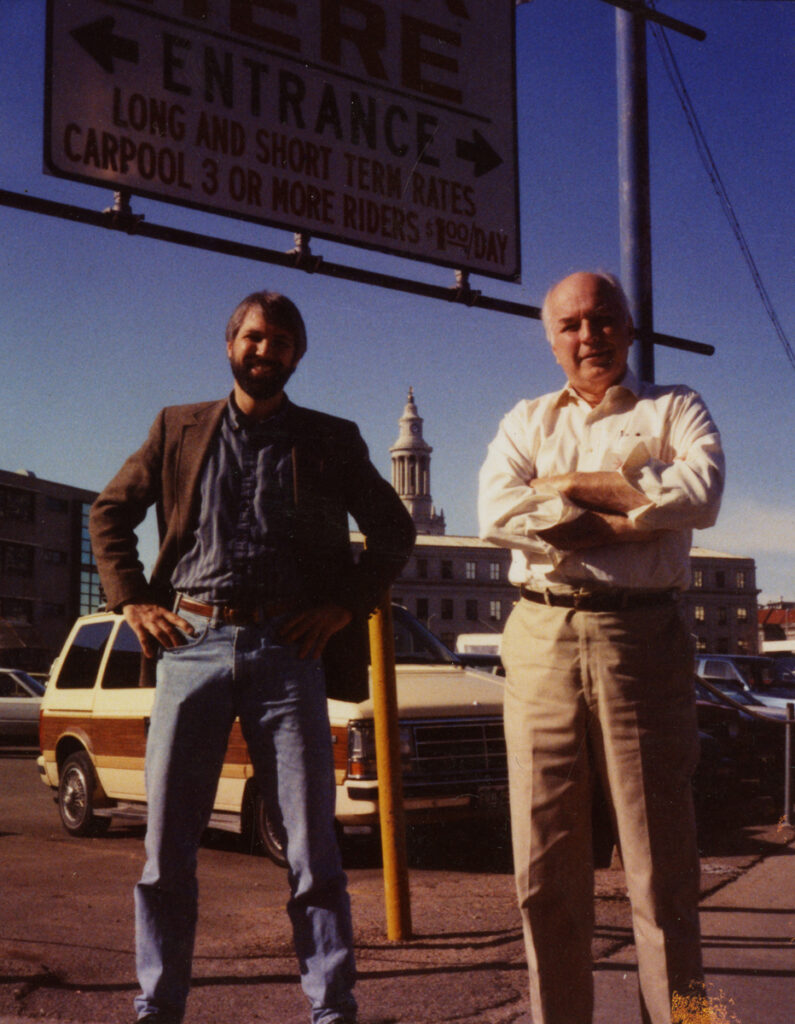
Steve (left) and Ken Shoulders in 1999. The father and son team spent decades designing flying machines and working on an alternative-energy project that even Ken described as “really nuts.”
In following the ideas of “frontier science” Shoulders made a life of taking the harder path. The difficulties he would create for himself, whether based on principle or temperament, are perhaps best exemplified by his decision to turn down a doctoral degree from MIT while he was working there in the 1950s, a formality that could have boosted his credibility with his EVO work. Steve remembers, “[His boss Arthur] von Hippel said, ‘I will get you a PhD; it’s assured.’ [Shoulders] said, ‘It’s not a problem; I’m not interested. I’ll bypass, thank you,’ and continued his work and then left. That’s typical. He just wasn’t interested in following convention.”
When we last spoke to Steve, he was still in the process of moving out of his father’s house and laboratory, trying to figure out what to do with all the leftover prototypes and lab equipment. “Things are at risk right now, but I’m trying to do what I can to preserve everything,” he said.
Once all the equipment and files are cleared out, traces of Ken Shoulders’s quixotic pursuits will remain in the hills he called his home and his workplace, lying there perhaps for some sharp-eyed hiker to stumble across.
“The aircraft would, if it got away from him, end up in the woods some place,” Steve said. “He’d usually go out there and find them, but there are plenty that could not be found. They’re probably still there in some form or another.”
The Kenneth R. Shoulders Papers were donated to the Science History Institute in 2015.

